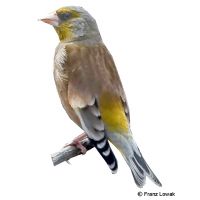Grey-capped Greenfinch (Chloris sinica)
| Grey-capped Greenfinch Chloris sinica | |
|---|---|
| Name | Grey-capped Greenfinch |
| Name Lat. | Chloris sinica |
| Synonym | Carduelis sinica |
| Family | Finches and Allies |
| Family lat. | Fringillidae |
| Order | Perching Birds |
| Order lat. | Passeriformes |
| Origin | Asia |
| Climate | Temperate |
| Diet | Woodland Bird seed, berries, buds |
| Keeping | Pair, group |
| Care Level | Moderate |
| Reproduction | Cup nest |
| Life Span | 6-12 years |
| Protection | No |
| Metric Units | |
| Size | 14 cm |
| Temperature | Room temperature |
| Housing | 80 x 40 x 40 cm |
| US Units | |
| Size | 5.5" |
| Temperature | Room temperature |
| Housing | 30" x 15" x 15" |
Distribution and habitat
The distribution range of the Chinese greenlings extends from China, Korea and Japan to southeastern Siberia, where they occur in open conifer and mixed forests as well as in cultivated land, gardens and parks from low elevations to 2,400 m above sea level. Today they are only offered as a cultivated form.
Cage size
The minimum cage size is 80 x 40 x 40 cm (L x W x H) for a pair. The cage size must not be undercut even in case of justified single keeping. For an additional 2 birds, species compatibility provided, the floor space must be increased by 25%. The cage must be placed in a bright, draught-free and quiet place at a height of at least 80 cm (except aviaries), have a rectangular base and be opaque on three sides, aviaries on one side. Keeping in an aviary is preferable.
Maintenance
The ground must be covered with sand, leaves, wood granulate, bark mulch or similar material and must be cleaned regularly. They need perching, hiding, roosting and nesting opportunities, as well as biotope-like furnishings with grasses, shrubbery and natural planting. At least 3 perches made of wood or branches of varying thickness and height must be installed in such a way that they can only be reached by flying and that the longest possible flight distance is created. Bathing facilities must be available at all times. The room temperature should not fall below 15 °C.
Diet
The species-specific range of feed consists of mixed seeds, available from specialist retailers as "mixed forest bird feed" in premium quality, supplemented with spruce and conifer seeds, plus foxtail millet, green millet, chickweed, dandelion, berries (e. g.E.g. rowan, firethorn), buds, buds (fruit) and, especially when rearing young, various germinated seeds, wild herbs, insects and insect larvae (ant pupae, small buffalos) and egg feed. Charcoal, vitamine lime, cuttlefish and shell grit are needed as digestive aids. Drinking water must always be available in birdbaths or in stable, open containers and, like food, must be offered fresh daily in clean containers.
A regular and varied diet and promotes health and prevents deficiency symptoms.
Reproduction and breeding
The sexes are similarly marked, the females are usually less intensely colored, have a brown head and rump, and are sand-colored on the underside.
They like to breed in open brushwood-covered cup-shaped nest bases made of mesh (wire baskets, emperor's nests, nesting blocks) in biotope-like planting (conifers). Suitable nesting material is small twigs, coconut fiber, sisal, moss, sharpie, grasses and small feathers for padding. The clutch consists of 3 to 5 eggs, the incubation period is about 13 days. The incubation period is, biologically speaking, from March to September when kept in outdoor aviaries.
Important
The birds may only be kept in pairs or groups. During the breeding season, due to their aggressive behavior towards birds of the same species, they should only be kept in pairs.
Keeping in a round cage is not allowed. For keeping in a group, an aviary is required.
They may be kept year-round in outdoor aviaries (minimum height 1.70 m), provided that a dry and draft-free shelter or a covered, protected aviary section is available to them. The facilities must be the same as those for cages.
In rooms, sufficient daylight or flicker-free artificial light (stroboscopic effect), corresponding to the light spectrum of natural sunlight, must be provided. The lighting duration must be between 8 and 14 hours per day. The day-night rhythm must be observed. An adequate indoor climate must be provided. The health condition of the birds must be checked daily.
Further literature can be found in your pet store.
References
Text: Othmar Sieberer; Image: Franz Lowak
Source: BMELV (1995): Tierschutzgutachten - Mindestanforderungen an die Haltung von Kleinvögeln; CLASSEN & MASSOTH (1992): Handbuch der Cardueliden, Band 2, Hanke Verlag
- Gemäß § 21 Abs. 5 Tierschutzgesetz idgF
